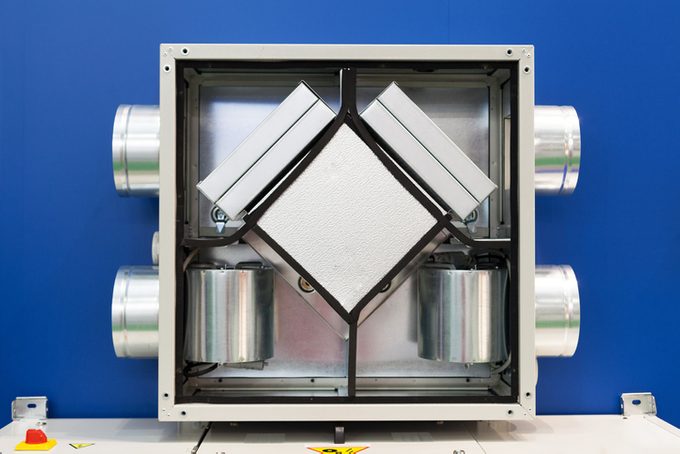An energy recovery ventilator (ERV) is standard equipment for today's tightly sealed homes. It circulates conditioned air so you can breathe.

Energy Recovery Ventilators: Should You Invest in One?

If your house was built according to current codes, it’s well-insulated and pretty much airtight. That means you’re warmer in the winter and cooler in the summer and you conserve energy, but there’s one problem: Air circulation.
To be healthy, your house needs to breathe as much as you do. You need oxygen-rich outside air moving through the house and stale indoor air moving out.
Keeping one or more windows open is one solution, but it isn’t practical in winter unless you’re like me and love sleeping in freezing temperatures. Even so, an open window only benefits that room.
Here’s a better idea: Installing an energy recovery ventilator (ERV). It’s an HVAC component that works on its own or in conjunction with your forced-air central heating and cooling system. It provides the entire house with fresh outdoor air while exhausting stale air. In most cases, it’s a good investment for anyone in a well insulated home.
On This Page
What Is an Energy Recovery Ventilator?

If you live in a recently built home, you may already have an energy recovery ventilator and not know it. Some codes, like the 2020 New York City Energy Code, require ERVs or heat recovery ventilators (HRVs) in new buildings.
Go into the basement or furnace room and look for a rectangular metal box measuring about two-and-a-half feet by two feet. If it’s there, you’ll find two ports on either side for ducts that run throughout the building as well as to the outside.
If you open the cover, you’ll probably see a pair of fans and a central core made of engineered cellulose or composite resin. This is a fixed plate or stationary core ERV, and it’s the most common residential type.
Here’s how it works:
Fans simultaneously suck air from indoors and outdoors through intake ports and direct it through the core, engineered to allow the two air streams to exchange heat and moisture. After passing through the core, exhaust ports carry indoor air outdoors and outdoor air into the house.
The air coming into the house after passing though an ERV is conditioned. It’s warmer than outdoor air during the winter and cooler during the summer. The conditioned air retains some moisture, but it’s drier than the outdoor air.
Types of Energy Recovery Ventilators
When you open the cover of the ERV in your new house, you may not find a stationary core. That’s just one type. There are three others that differ by the type of heat exchanger they employ.
- Rotational (wheel): A plastic wheel spins between the indoor and outdoor air intake ports, transferring heat and moisture between them. This type of heat exchanger is common in larger ERVs found in hospitals and schools.
- Heat-pipe: Refrigerant-filled copper tubes transfer heat from outgoing air to the incoming fresh air stream. The warmer air stream vaporizes the refrigerant while the cooler stream condenses it, releasing heat into the cooler stream. This isn’t a common residential system.
- Runaround coils: Coils filled with a water-glycol mixture absorb heat from the warmer air stream and transfer it to the cooler stream. This technology works best for large systems where the incoming and outgoing air streams are widely separated.
- Fixed plate or stationary core: Most residential ERV’s are this type. Both incoming air streams pass through a stationary core engineered with special materials to allow the exchange of air and moisture between them.
Not all these heat exchange technologies allow for moisture exchange, so sometimes the ERV features a desiccant to absorb moisture from the air.
ERV vs. HRV
Like an ERV, a heat recovery ventilator (HRV) exchanges heat between the incoming air streams, but it doesn’t exchange moisture. Instead of a moisture-absorbing core, it comes with a metal one. Excess moisture condenses on the metal and drips into a tray.
An HRV transfers heat more efficiently than an ERV, and works better in Northern climates where the air is colder and drier.
ERV Benefits and Drawbacks

An ERV is a useful HVAC component for several reasons, but there are also reasons why you might not want one.
Benefits
- Fresh air everywhere: An ERV supplies fresh air to every room, not just those with an open window. An added benefit: The security of keeping windows closed and locked.
- Humidity control: While it’s no substitute for a dehumidifier, an ERV reduces the moisture in the air it blows into the house, especially beneficial in a humid climate.
- Balanced air pressure: By exhausting as much air as it blows, an ERV keeps the air pressure in the house balanced. That makes the environment more comfortable and reduces the likelihood of leaks developing in the building envelope.
Drawbacks
- Uses electricity: An ERV uses about 40 watts of electricity per hour. That isn’t much, but adds up if you run it 24/7. At the national average rate of $0.23 per kWh, that would cost almost $100 per year.
- Noise: Most ERV’s run quietly, but they do contain fans, so they aren’t silent.
- Expensive to install: ERV’s can be tied into the existing HVAC ductwork, but they work best when they have their own. Installing new ducts and vents is a major project.
Cost To Install an ERV
The average cost to purchase an ERV runs between $1,000 and $1,900. To install one, you also need to purchase ductwork and other materials. These cost between $800 and $1,900 depending on the size and configuration of your house.
If you do the installation yourself, that’s all you’ll have to pay. If you opt for professional installation, you’ll pay an extra $3 to $10 per linear foot of ductwork.




















